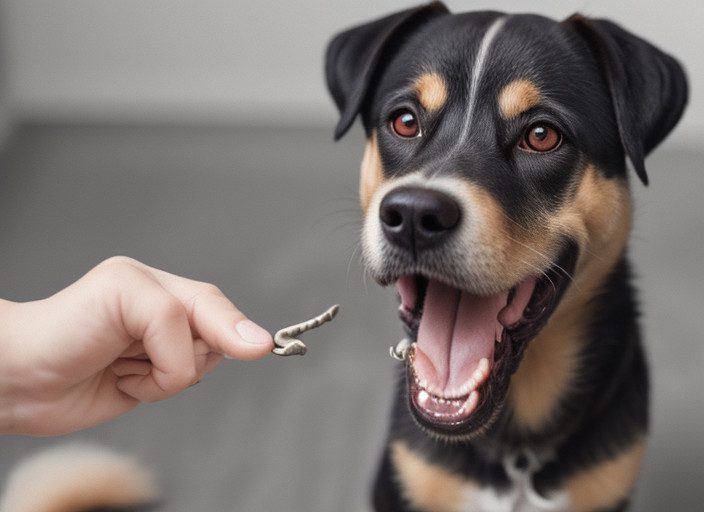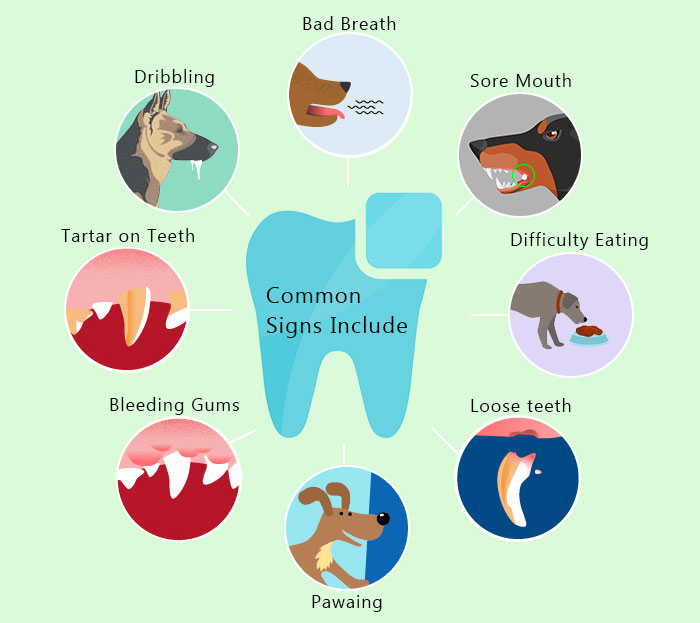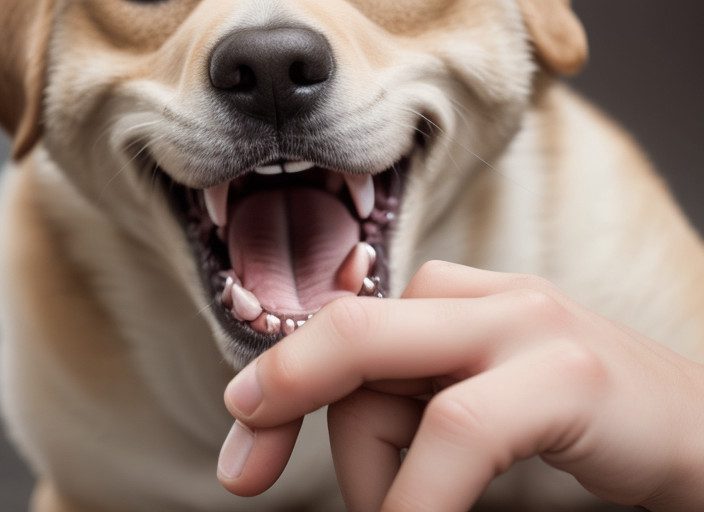Common dog teeth problems include plaque buildup and gum disease, which can lead to tooth decay and pain. Regular dental care is essential to prevent these issues and maintain your dog’s overall health.

As responsible pet owners, it is crucial to prioritize your dog’s dental hygiene to prevent potential health problems. Neglecting their teeth can result in discomfort and costly treatments. By implementing a proper dental care routine, such as regular brushing and dental check-ups, you can ensure your furry friend enjoys a healthy and happy life.
Stay tuned as we delve deeper into the importance of dental care for dogs and how you can effectively maintain your canine companion’s oral health.
Introduction To Canine Dental Health
Canine dental health is a crucial aspect of overall pet wellness. Just like humans, dogs can experience a range of dental issues that can impact their health and quality of life. Understanding the importance of oral care in dogs and the prevalence of dental issues in canines can help pet owners take proactive steps to ensure their furry friends maintain healthy teeth and gums.
Importance Of Oral Care In Dogs
Maintaining good oral hygiene in dogs is essential for their overall well-being. Regular dental care can prevent painful conditions such as gum disease and tooth decay, which can impact a dog’s ability to eat and play comfortably. Neglecting dental health can also lead to more serious health problems, as bacteria from the mouth can enter the bloodstream and affect other organs. Proper oral care is vital for ensuring a dog’s long-term health and happiness.
Prevalence Of Dental Issues In Canines
Dental issues are common among dogs of all breeds and ages. Statistics show that by the age of three, most dogs have some form of dental disease. This can include plaque and tartar buildup, gum inflammation, and tooth decay. Factors such as diet, genetics, and lack of dental care can contribute to the prevalence of these issues. Being aware of the high likelihood of dental problems in canines can prompt pet owners to prioritize regular dental check-ups and at-home oral care for their furry companions.


Recognizing Dental Disease In Dogs
Identifying dental issues in dogs is crucial. Common teeth problems include plaque buildup, gum disease, and tooth decay. Regular dental check-ups and at-home care are essential for maintaining your dog’s oral health.
Recognizing Dental Disease in Dogs
Dental problems are common in dogs, and it’s essential to recognize the signs early to prevent severe complications. Dogs can’t express their discomfort, so it’s up to the owner to identify any potential dental issues. The following are some of the signs to look out for when recognizing dental disease in dogs.
Halitosis: Not Just Bad Breath
Halitosis, or bad breath, is one of the most common signs of dental disease in dogs. While some dogs naturally have bad breath, a sudden change in the odor can be an indication of dental problems. The root cause of halitosis in dogs is the buildup of bacteria in the mouth due to poor oral hygiene. Owners should examine their dog’s mouth for any signs of plaque, tartar, or inflamed gums.
Behavioral Changes as Indicators
Dental disease can cause behavioral changes in dogs. If a usually active dog suddenly becomes lethargic, it could be a sign of dental pain. Dogs may also show reluctance to eat or chew their food, which can lead to weight loss. Owners should observe their dog’s behavior and consult a veterinarian if they notice any changes.
To prevent dental disease in dogs, owners should establish a dental care routine that includes brushing their dog’s teeth, feeding them a healthy diet, and providing them with dental chews or toys. Early recognition of dental problems can prevent severe complications and improve the overall health and well-being of dogs.
Plaque And Tartar Build-up
Dogs are prone to plaque and tartar build-up on their teeth, which can lead to various dental problems.
Formation And Consequences
Plaque is a sticky film of bacteria that forms on the teeth. Over time, it hardens into tartar, causing irritation and inflammation of the gums.
Consequences: Tartar build-up can result in bad breath, tooth decay, gum disease, and eventual tooth loss if left untreated.
Home Care Techniques
- Regular Brushing: Use a dog-specific toothbrush and toothpaste to brush your dog’s teeth at least 2-3 times a week.
- Dental Chews: Provide dental chews or toys to help reduce plaque and tartar build-up.
- Diet: Feed your dog a balanced diet to promote good dental health.
:strip_icc()/GettyImages-148198309-58dbca5007ad46edaa84c89b70f41de1.jpg)
:strip_icc()/GettyImages-148198309-58dbca5007ad46edaa84c89b70f41de1.jpg)
Periodontal Disease In Dogs
Periodontal disease in dogs is a common and serious dental issue that affects a large percentage of our furry companions. This condition primarily targets the gums and supporting structures of the teeth, leading to discomfort, pain, and potential tooth loss if left untreated. Understanding the stages and symptoms, as well as professional treatment options, is crucial for maintaining the oral health of our beloved dogs.
Stages And Symptoms
Stage 1: Initial signs may include bad breath, mild redness, and swelling of the gums. Stage 2: Progression can lead to tartar buildup, bleeding gums, and visible discomfort. Stage 3: Advanced symptoms involve loose teeth, severe pain, and difficulty eating.
Professional Treatment Options
1. Dental Cleaning: Professional cleaning by a veterinarian to remove plaque and tartar. 2. Periodontal Surgery: In severe cases, surgical intervention may be necessary to address deep pockets and damaged tissue. 3. Antibiotics: Prescribed to manage infection and prevent further complications.
Tooth Decay And Cavities
Dogs, just like humans, are susceptible to dental issues, and one common problem they face is tooth decay and cavities. Tooth decay occurs when bacteria in the mouth produce acids that attack the tooth enamel, leading to cavities. Understanding the causes, prevention, interventions, and cavity treatments is crucial for maintaining your dog’s oral health.
Causes And Prevention
The primary causes of tooth decay and cavities in dogs include plaque buildup, poor diet, and lack of dental care. Plaque accumulation promotes bacterial growth, which can erode the enamel and lead to cavities. Preventive measures such as regular teeth brushing, dental chews, and oral rinses can help reduce the risk of tooth decay in dogs.
Interventions And Cavity Treatments
When it comes to interventions for tooth decay in dogs, professional dental cleanings and oral examinations by a veterinarian are essential. If cavities are detected, treatments such as fillings, root canals, or tooth extractions may be necessary to address the issue and prevent further damage.


Broken Teeth And Trauma
Broken teeth and trauma in dogs can cause pain and discomfort, affecting their ability to eat and play.
Common Causes Of Dental Injuries
- Chewing on hard objects like rocks or bones
- Accidents or falls
- Aggressive behavior toward other animals
First Aid And Veterinary Care
- Inspect the mouth for broken teeth or bleeding
- Apply a cold compress to reduce swelling
- Contact a veterinarian for immediate evaluation
Canine Oral Tumors
Canine oral tumors are a common dog teeth problem that can affect their overall health. Early detection and regular dental check-ups are crucial for timely treatment and prevention of complications. Regular teeth cleaning and monitoring for any unusual lumps or growths can help maintain your dog’s oral health.
Canine oral tumors are a common type of dog teeth problem that can cause discomfort, pain, and even tooth loss in your furry friend. These tumors can be benign or malignant, and their severity depends on the type, size, and location of the tumor. In this section, we will discuss the types and diagnosis, as well as the treatment and prognosis of canine oral tumors.
Types And Diagnosis
Canine oral tumors can be divided into two main categories: benign and malignant. Benign tumors are non-cancerous and usually do not spread to other parts of the body. However, they can still grow and cause problems if they are not treated. Malignant tumors, on the other hand, are cancerous and can spread to other parts of the body, making them more dangerous.
Diagnosing canine oral tumors requires a thorough examination by a veterinarian. In some cases, X-rays, CT scans, or biopsies may be needed to determine the type and severity of the tumor. It is important to catch these tumors early on to increase the chances of successful treatment.
Treatment And Prognosis
The treatment for canine oral tumors depends on the type and severity of the tumor. In some cases, surgery may be necessary to remove the tumor and any affected tissue. Radiation therapy or chemotherapy may also be used to shrink the tumor or prevent it from spreading.
The prognosis for canine oral tumors varies depending on the type and stage of the tumor, as well as the age and overall health of your dog. Some benign tumors can be easily removed with surgery and have a good prognosis, while malignant tumors may require more aggressive treatment and have a lower chance of a full recovery.
In conclusion, canine oral tumors are a serious dog teeth problem that requires prompt attention from a veterinarian. By understanding the types and diagnosis, as well as the treatment and prognosis, you can help ensure the best possible outcome for your furry friend.


Dental Care Routine For Dogs
When it comes to maintaining your dog’s health, dental care is often overlooked. However, dental problems can lead to serious health issues for your furry friend. Establishing a proper dental care routine for your dog is crucial in preventing common teeth problems and maintaining their overall well-being.
Daily Brushing Techniques
Daily brushing is the most effective way to prevent plaque and tartar buildup, which can lead to gum disease and tooth decay in dogs. Use a pet-specific toothbrush and toothpaste to gently brush your dog’s teeth, ensuring you cover all surfaces. Be patient and gentle, and offer positive reinforcement to make the experience more enjoyable for your pet.
Diet And Chew Toys For Dental Health
Proper nutrition plays a significant role in your dog’s dental health. Feeding them dental-specific or dry kibble can help reduce plaque and tartar buildup. Additionally, offering dental chew toys can help keep your dog’s teeth clean and provide a source of enrichment and entertainment.
Advanced Dental Treatments
Surgical Procedures And Extractions
Dogs may require surgical procedures and extractions for severe dental issues.
Anesthesia And Post-operative Care
Proper anesthesia and post-operative care are crucial for successful dental treatments.


Preventing Dental Problems
Preventing dental problems in dogs is essential for their overall health and well-being. Just like humans, dogs are susceptible to a range of dental issues, and as pet owners, it’s our responsibility to ensure that their oral health is properly cared for. By taking proactive measures and staying informed about common dental problems, we can help our furry friends maintain healthy teeth and gums throughout their lives.
Regular Veterinary Check-ups
Regular veterinary check-ups play a crucial role in preventing and addressing dental issues in dogs. Scheduling routine appointments with a veterinarian allows for professional assessment of your dog’s oral health, early detection of potential problems, and timely intervention when necessary. During these check-ups, the vet can perform a thorough dental examination, recommend dental cleanings, and guide at-home dental care.
Educational Resources For Pet Owners
Accessing educational resources tailored for pet owners can significantly contribute to preventing dental problems in dogs. Online platforms, such as reputable pet care websites and forums, offer valuable information on dental hygiene, proper brushing techniques, dental-friendly diets, and the importance of chew toys. These resources empower pet owners to make informed decisions regarding their dog’s dental care, ultimately helping them maintain good oral hygiene and prevent common dental issues.
Frequently Asked Questions
What Is The Most Common Dental Problem In Dogs?
The most common dental problem in dogs is periodontal disease, which includes gum inflammation and tooth decay.
When To Be Worried About Dogs’ Teeth?
Monitor dogs’ teeth for signs of bad breath, tartar buildup, loose or broken teeth, bleeding gums, and difficulty eating. Regular dental check-ups are essential for maintaining good oral health.
What Do Unhealthy Dog Teeth Look Like?
Unhealthy dog teeth may appear discolored, covered in tartar, or have visible cavities. Bad breath and swollen gums are also signs of dental issues. Regular dental check-ups are crucial for maintaining your dog’s oral health.
What Are The Stages Of Bad Dog Teeth?
The stages of bad dog teeth include plaque buildup, gingivitis, periodontitis, tooth decay, and tooth loss. Plaque buildup is the first stage, followed by inflammation of the gums or gingivitis. If left untreated, it can progress to periodontitis, causing bone and tissue loss around the teeth.
Tooth decay and eventually tooth loss can occur if the problem persists.
What Are Common Dog Teeth Problems?
Common dog teeth problems include plaque, tartar, gum disease, tooth decay, and fractured teeth.
Conclusion
In caring for your dog, it’s crucial to address common teeth problems promptly. From plaque buildup to periodontal disease, maintaining good oral hygiene is vital. Regular dental check-ups and proper home care can prevent these issues. By staying vigilant and proactive, you can ensure your furry friend’s dental health and overall well-being.
